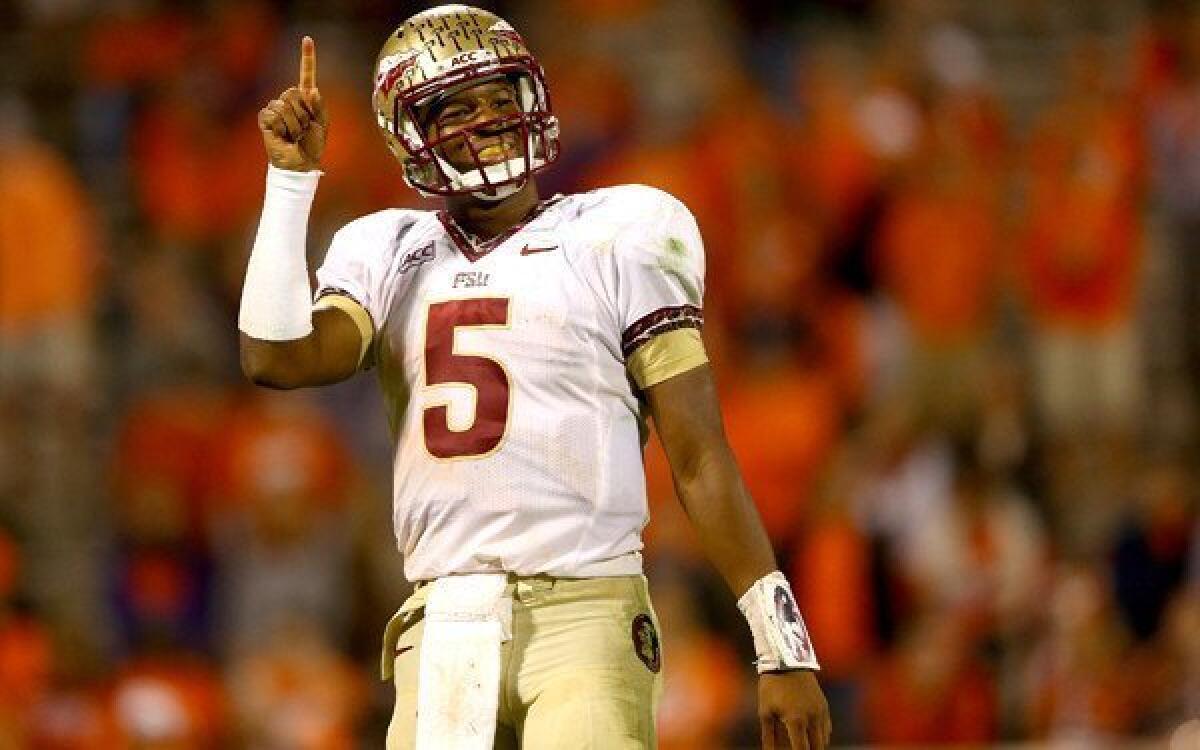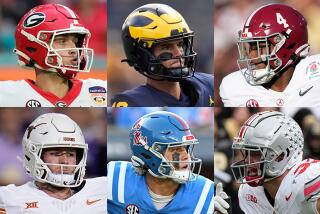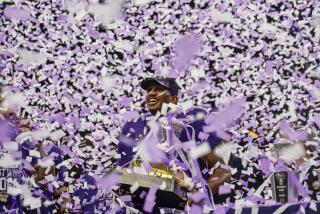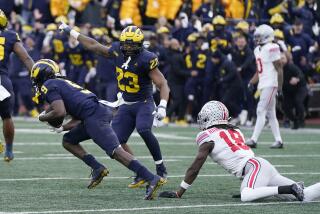In final year of the BCS, one constant remains: controversy

- Share via
The Bowl Championship Series has been ripped, ridiculed ravaged and pilloried — and that’s by the people who like it.
The people who don’t have treated it like a demon child.
No one has ever called the BCS boring.
The 16th and last season of the pin-the-tail-on-the-donkey began Sunday with Alabama on top and a lot of commotion down below.
Alabama surprised only a few sequestered monks as the first BCS leader with an average of .9841.
After hearing for weeks their team might be the real No.1, Oregon fans must have freaked out when Florida State was No. 2 by a slight .9348 to .9320 margin.
Oregon is No. 2 in both polls used in the BCS formula but is No. 4 in the computers while Florida State is No. 1 in that index.
Oregon, however, has the toughest part of its schedule remaining as its final five Pac-12 opponents have a combined record of 25-8.
If Oregon is undefeated and wins the Pac-12, considered either the first- or second-best league this year, how could it be denied?
Ohio State is No. 4, followed by, um, something called Missouri.
Stanford used its win over UCLA and half the top 10 being wiped out to jump all the way to No. 6 in the BCS, followed by Miami, Baylor, Clemson and Texas Tech.
UCLA debuted at No. 12.
If we’re lucky, the last BCS season will end up one final train wreck. A sport with this kind of postseason system gets what it deserves.
Alabama is trying to become the first team to win three consecutive national titles since Minnesota in the early 1930s.
USC came close in 2005, falling a couple of inches short of defeating Texas in the BCS title game at the Rose Bowl.
The BCS was implemented in 1998 as a way to pair No. 1 vs. No. 2 in a sport that was long paralyzed by intricate bowl contracts that sometimes prevented the top teams from playing.
The BCS became possible when the Rose Bowl agreed to join and it has somehow lasted 16 years using a combination of polls and computers to pick the top two teams.
Next year, a 13-person selection committee will replace the BCS and choose the top four teams for a playoff.
Meaning: Next year at this time, you’ll be mad at Condoleezza Rice instead of some faceless computer nerd.
The BCS has done a decent job in pairing No. 1 vs. No. 2 with a few cataclysmic exceptions.
The biggest was USC in 2003 being No. 1 in both polls but finishing third in the BCS standings.
Louisiana State defeated Oklahoma for the BCS title, but the Associated Press broke ranks and awarded its title to USC.
In 2011, Alabama got to the title game without winning its own division of the Southeastern Conference.
A few facts and figures entering the last BCS season:
Oklahoma has spent the most weeks on top, 20, despite winning only one championship in 2000.
Ohio State and USC have 15 weeks at No. 1, and LSU and Alabama have spent 10 weeks but have claimed five of the first 15 BCS titles.
The first No. 1 in BCS history was, of all teams, UCLA. The Bruins opened on top in October 1998 and spent one week there before falling to No. 3. UCLA has never been back to No. 1.
Weekend wrap
-- Recap on Oregon’s 62-38 win over Washington State: Oregon defensive coordinator Nick Aliotti blasted Cougars Coach Mike Leach after the game for scoring on two late touchdown passes against the Ducks’ scout team. “I think it was low-class and it was BS to throw the ball when the game was completely over,” Aliotti said.
Oregon pulled its starters in the fourth quarter with a 62-24 lead, but Leach played his front-line offense until the end. Quarterback Connor Halliday set a Football Bowl Subdivision record with 89 pass attempts. He completed 58 of those for 557 yards. The Cougars finished with two rushing yards.
Halliday broke the record of 83 set by Purdue quarterback Drew Brees in 1998. Halliday said he knew he was going to throw a lot, but “nobody ever thinks 89 is going to be the number.”
You want some perspective on Halliday’s 89 attempts? In 2008, Navy attempted 88 passes ... for the season.
-- Marcus the Magnificent: Oregon quarterback Marcus Mariota added 33 more passes without an interception to his ongoing total, which stands at 265. Mariota’s last interception came in the first half of last year’s Nov. 17 home loss against Stanford. “Marcus is an amazing, driven guy,” Oregon Coach Mark Helfrich said.
-- Is the Pac-12 Networks’ dispute with DirecTV hurting the conference in the polls? Arizona State improved to 5-2 with a 53-24 win over No. 20 Washington in a game televised on the Pac-12 Networks. Arizona State rose to No. 9 in Jeff Sagarin’s ratings Sunday, but the Sun Devils remained unranked in the AP, USA Today and Harris polls.
-- Alabama almost pitched a perfect game against Arkansas. The Crimson Tide had no penalties, no turnovers and gave up no points in a 52-0 win over Arkansas in Tuscaloosa.
-- And you wonder why polls drive people crazy? Central Florida scored a 38-35 win at No. 8 Louisville on Friday night, yet Louisville appeared at No. 16 in the coaches’ poll, nine spots ahead of UCF. The Golden Knights’ only loss this year was by three points to South Carolina. The coaches also have two-loss Texas A&M; at No. 15, two spots ahead of one-loss Auburn. It seems like only last Saturday that Auburn defeated Texas A&M; in College Station.
-- Bad losses will kill you. Oregon State (6-1) remains unranked despite being tied with Oregon atop the Pac-12 North Division. The Beavers are still being penalized for their season-opening loss to Eastern Washington. Brigham Young has defeated Texas, Utah State, Georgia Tech and Houston but is still suffering from an opening defeat at Virginia.
-- End quote: Washington State Coach Mike Leach, following his team’s 62-38 loss at Oregon: “They made us look worse than we actually are.”
More to Read
Go beyond the scoreboard
Get the latest on L.A.'s teams in the daily Sports Report newsletter.
You may occasionally receive promotional content from the Los Angeles Times.











